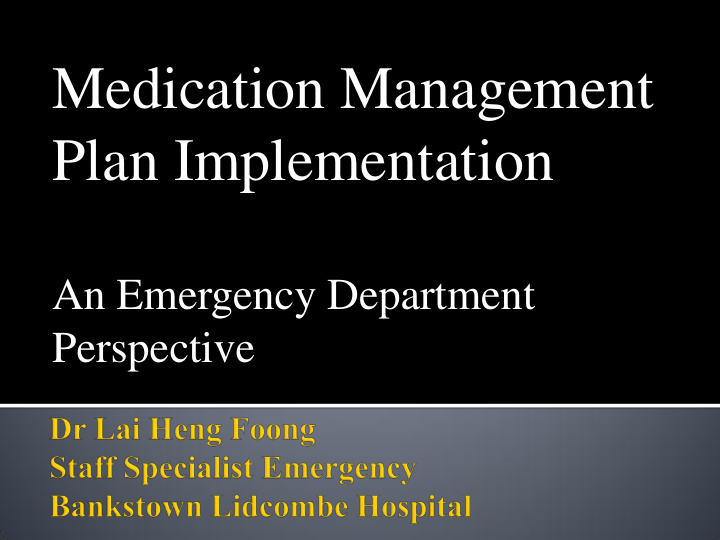



Medication Management Plan Implementation An Emergency Department Perspective
Mixed Adult and Paediatric Major Urban 51000 presentations per year Approximately 150 patients per day 40% admission rate
Jointly started by hospital pharmacy and ED Hospital wide short education sessions including ED Posters Intensive education sessions in Dec 2014/January 2015 Continuing posters/education session (but less intensive)
District Educator Interactive 20 minute session All ED doctors and nurses Daily sessions HETI online module ED Staff specialist : JMO teaching session, Registrar teaching session, Facebook page reminders, email reminders
16 Dec 2014: 71% compliance with MMP Commitment by hospital pharmacy, Emergency department and hospital executive to improve compliance with MMP Education and senior buy in
MMP added to JMO Ward checklist Directive from hospital executive that MMP must be kept at the bedside
Extension of what we should be doing anyway Advised staff to complete when they are taking the history Doubling up between MMP and medical record Allowed to use MMP only In practice written in both Does not take long
Time to complete Senior buy in Nurses had difficulty getting medication lists from GPs Inpatient teams think it is ED’s job to do it
100% compliance in February, 2015 In June, 2015, still >95% compliance Continuing education sessions
Consultant checking on rounds Consultant sign off and Nursing sign off Regular teaching sessions for JMO/Registrar Emails and social media (Facebook page reminders) Pharmacist in ED checking All clinical staff are educated from district educators
MMP Policy Directive developed, approved by Clinical Council and disseminated to staff MMP Resource Folders Reference cards for MMP issued to clinical staff MMP Integration into existing QI initiatives eg Patient Journey Boards Process commences in ED for emergency admissions and Pre-admission Clinic for elective surgical patients Blue handover stickers for medical officers amended to include MMP as a handover action
Four consecutive audits were conducted from December 2014 to February 2015. Total of 401 MMPs captured Audit focused on use of MMP on admission and BPMH
100% 98% 100 94% 90 80 73% % of patients with MMP 70 60 50 40 30 20 10 0 16-Dec-14 28-Jan-15 04-Feb-15 10-Feb-15
100 92% 90 87% 80 70 % of patients 60 61% 50 40 N 1 =87 39% N 2 =103 30 N 3 =105 N 4 = 106 20 10 0 16-Dec-14 28-Jan-15 4-Feb-15 10-Feb-15
Percentage of MMPs initiated by profession Pharmacist 1 Medical Officer Nurse 0% 20% 40% 60% 80% 100%
MMP included on Patient Journey Boards (PJB) – Business Rules developed and implemented MMP included in nursing clinical handover tools Peri-operative clinical handover document includes MMP Orientation programs reviewed to include MMP Pharmacists rostered to attend PJB rounds Pharmacists allocated pagers to facilitate their attendance in PJB rounds
Need senior ED clinical leadership Patient safety enhancement Not a massive change from current practice Collaborative approach between ED and inpatient team Regular reinforcement
The MMP project won the South Western Sydney Local health district quality award for 2015 for category of " Patient and carers as partners". The title of the submission was " The new multidisciplinary team : Doctors , pharmacists, nurses administrative staff and patients.
Recommend
More recommend